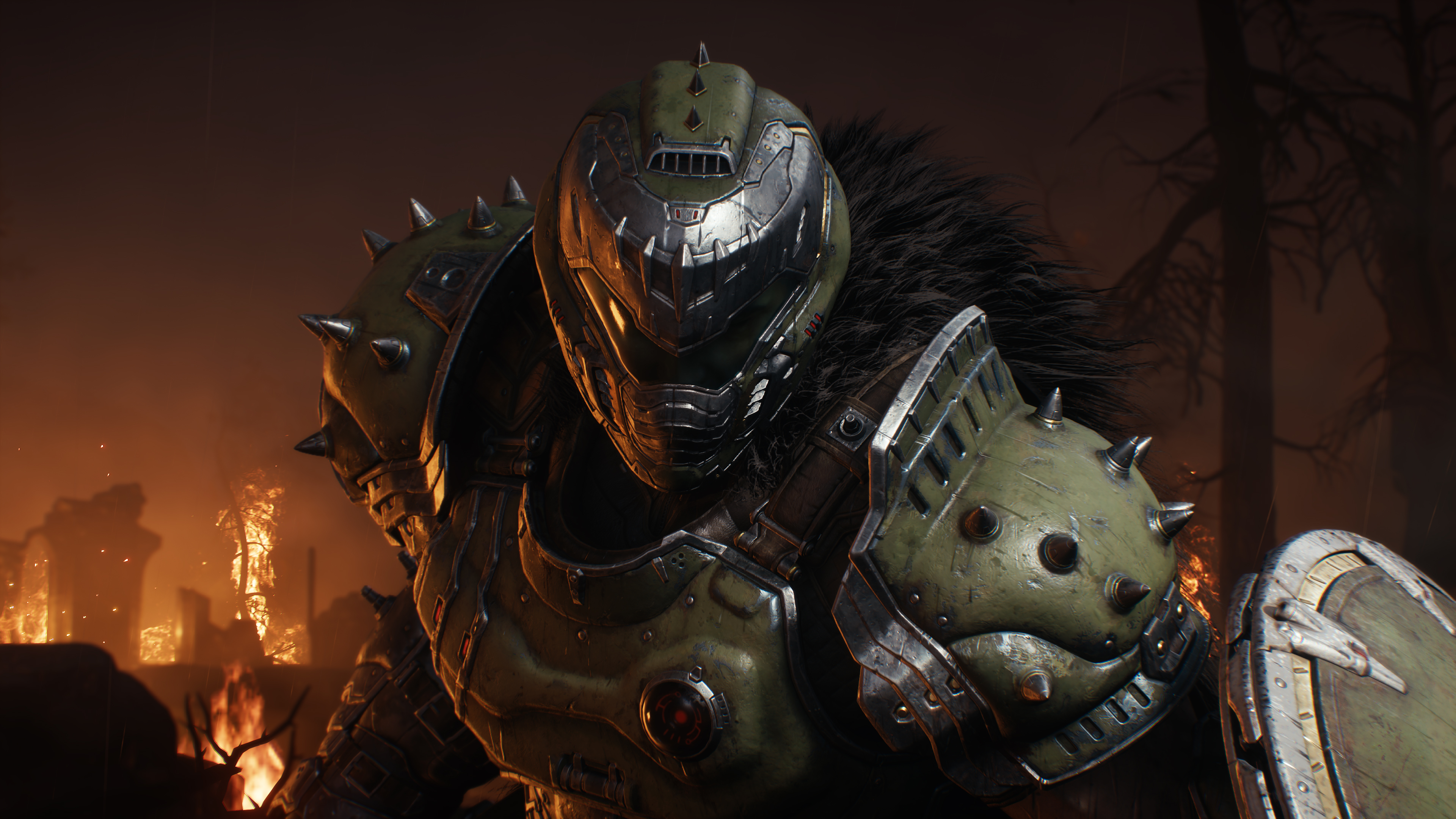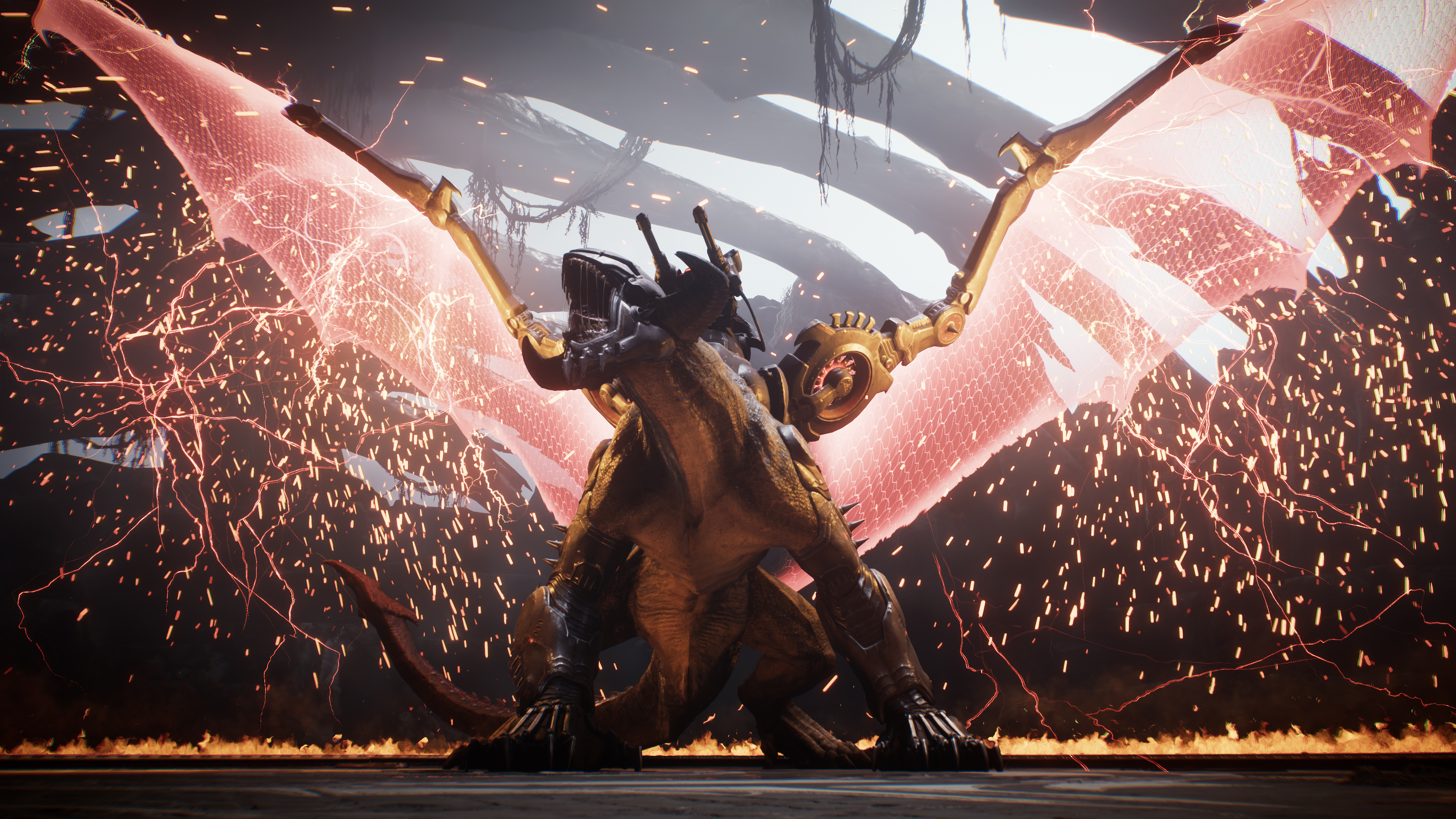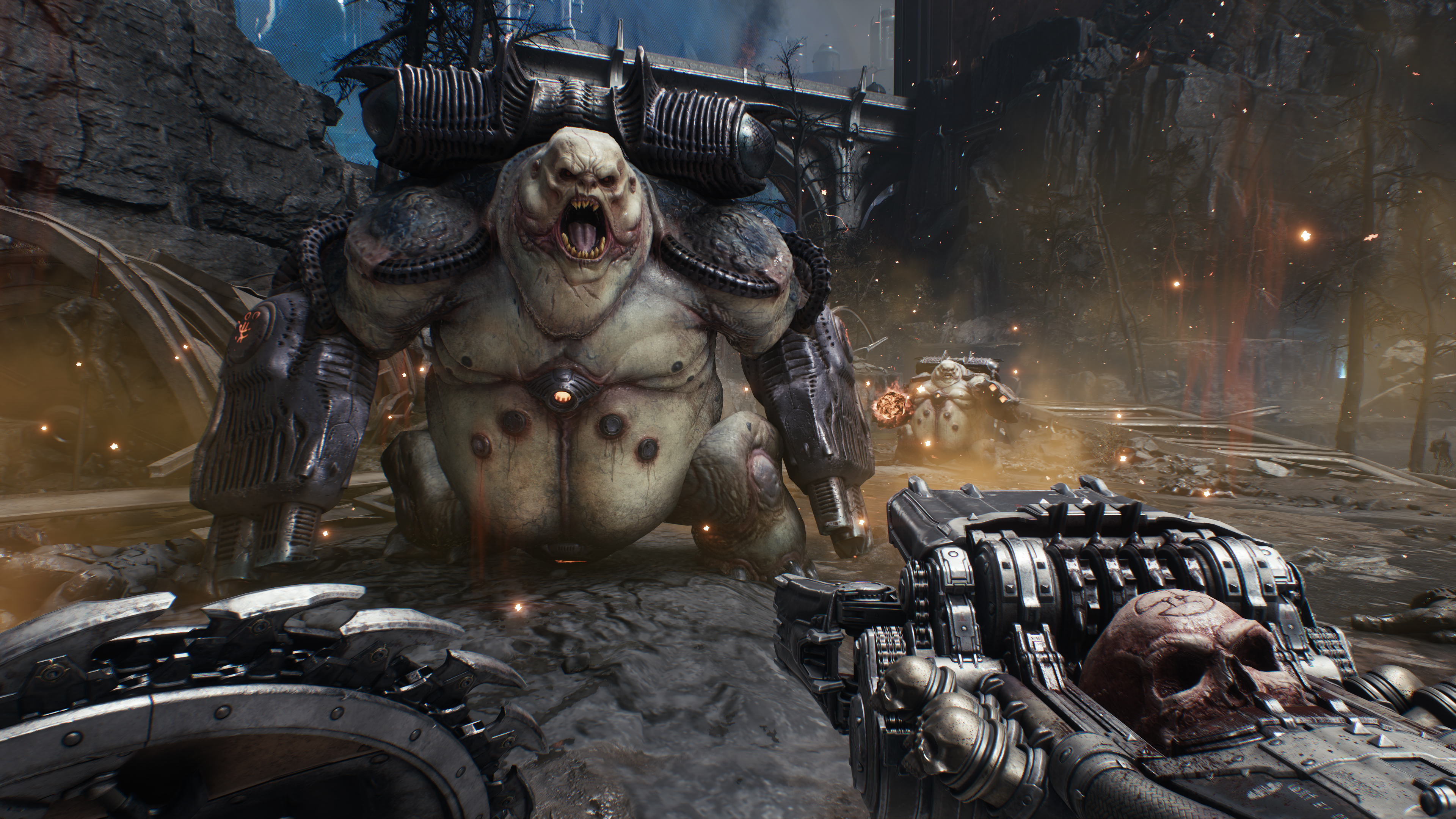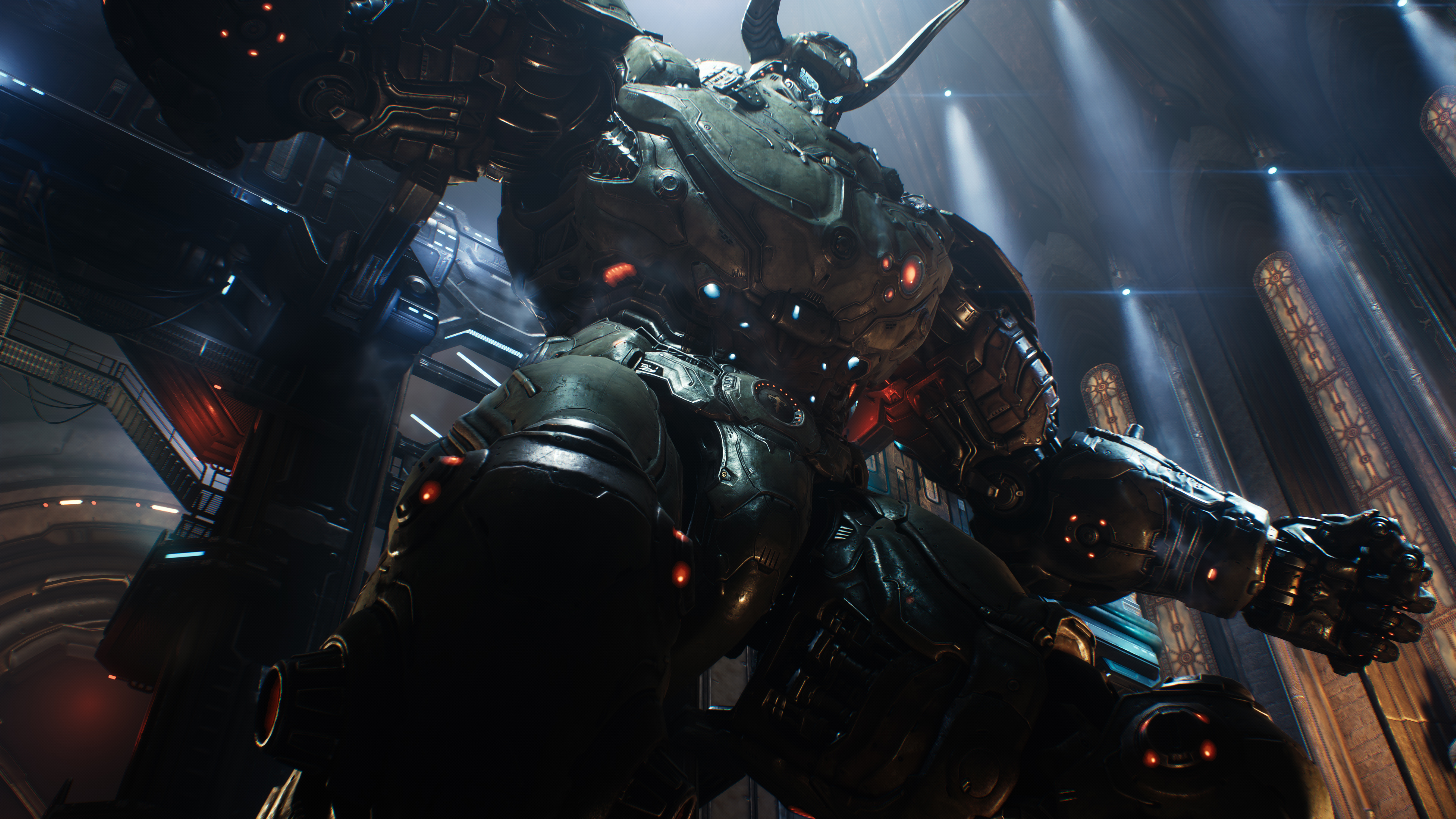
When Doom: The Dark Ages was revealed earlier this month, I was struck by how different it looks from Doom Eternal. This might seem an odd thing to say, given both games are hyper-slick, hyper-violent shooters about a very angry man killing demons inside living metal album covers. But the differences become much clearer when you compare The Dark Ages' reveal to Doom Eternal's various trailers.
In Eternal's videos, the Doom Slayer is constantly getting airborne, bouncing on jump-pads, swinging between monkey bars, grappling onto enemies with the shotgun's alt-fire. It's like a Mario game directed by David Cronenberg. By comparison, in the Dark Ages reveal trailer, the Slayer's movement is almost purely horizontal. He strides inexorably forward, taking out whole clusters of enemies with weapons like that awesome skull-shrapnel flak cannon. When attacked he stands his ground, countering enemy strikes, and turtling up behind a massive shield. Aside from one short drop off a ledge, his feet never leave the ground.
Naturally, you can't judge an entire game based on a couple of minutes of (highly curated) footage. But these observations are backed up by comments from id Software itself. Speaking to GamesRadar shortly after the reveal, game director Hugo Martin stated that "If you were an F22 fighter jet in Doom Eternal, this time around we wanted you to feel like an Abrams tank."
Does this mean id Software has spent multiple games and more than 10 years of development trying to replicate the feel of the original Doom in a modern shooter, and getting it wrong?
Like Eternal, Doom: The Dark Ages is intended as a different take on the series' demon-slaying action. What's really interesting, though, is that Martin says these changes are intended to make the Dark Ages feel more like the original 1993 Doom. "At the start of every development cycle, I play the original Doom again, and have the team play it too. I realized that we still didn't hit the mark," Martin says. Regarding the Abrams tank comment, he adds. "For long-time fans of the series, people who played the original Doom, you'll see it's really a return to form."
Yet Martin's statement implies the team did this with Eternal and Doom 2016 as well: played the original to see how it ticks, and tried to build a game that evokes that sensation. Does this mean id Software has spent multiple games and more than 10 years of development trying to replicate the feel of the original Doom in a modern shooter, and getting it wrong?
I don't know. But if it is true, then I hope Doom: The Dark Ages fails all over again.

I'll explain why in a moment. First, we should probably take Martin's comment about The Dark Ages being a return to form with a tiny pinch of salt, if only because plugging a new game by lightly dinging the previous one is a standard marketing ploy. "We didn't quite nail the blood boiling in Blood Boiler 17, but for Blood Boiler 18, we've completely overhauled the blood boiling system, and we really feel like we've captured the essence of boiling large amounts of blood." That's not to say this is what Martin is doing; game development is a highly iterative medium, so it's natural for developers to discuss how they've attempted to improve upon previous work. But it is also a tried and tested way to get players hyped for your shiny new game, especially when some elements of your last game proved controversial, as was the case with Doom Eternal.
In this specific circumstance, however, I can see why Martin might feel he hasn't found the secret sauce that has kept 1993's Doom relevant for over thirty years. And it isn't because Doom or Doom Eternal were bad (they absolutely weren't). It's because Doom is a deeply weird and elusive design. It's a tooth and nail action game, but also a tense and spooky horror game. It's dingy and atmospheric, but also brightly coloured and often outright gaudy. Even something as simple as its movement speed is the subject of intense debate. Some players think it's incredibly fast, while others believe it's quite slow and inertial.
In other words, Doom doesn't break down into easily analysed component parts. It's a holistic, organic flower of a game—admittedly one of those giant rainforest flowers that smells of rotting meat, but a flower nonetheless. That's why its shotgun feels so damn good after thirty years, why its levels are so fun to unpick after countless playthroughs. Like all the best art, there's a point at which its quality defies logical explanation, and its brilliance is understood not through any articulated thought, but through the lurch in your stomach, the flutter of your heart.

That's the game Hugo Martin & co keep coming back to, and in doing so, id Software takes something different from it every time. With Doom 2016, it homed in on its violence and propulsive action, connecting the two together through its glory kill mechanic. In Doom Eternal, the studio doubled down on the idea of being one man pitched against the entire forces of hell, elevating the ducking and weaving of the original Doom into a Sekiro-like ballet of precision.
Each of id's reboots is an interpretation of a different element of Doom.
When Martin ran through the original Doom again for the Dark Ages, it wasn't the demons, but their projectiles that caught Martin's attention. "I noticed right away how slow those projectiles move—it just dawned on me that that is the maze. The movement is more horizontal as you weave your way between the projectiles, and every projectile mattered in the original Doom." This is why the Slayer appears more grounded in The Dark Ages. id wants players to have to think more about how to navigate that maze, giving you tools to block and even counter them.
In this manner, each of id's reboots is an interpretation of a different element of Doom, fixating upon a specific aspect of the original and then building a game around it. And this is why I don't want Martin to, as he puts it "get it right", to discover some fundamental seed that makes Doom what it is. Doom 2016 and Doom Eternal may not be as timelessly brilliant as the original, but they're both comfortably among the best single-player shooters of the last decade, if not the best. Moreover, they're each interesting games in their own right, in conversation with the original, but assembling something new out of its ideas.

I don't want Martin to discover the essence of Doom. Instead, I want him to keep trying. I want Doom: The Dark Ages to put its own stamp on the original, to reinterpret this classic text in a whole new way. Then I want Martin to feel unsatisfied by it and try again. I want him to keep making these hyper-specific riffs on it, that extract and expand upon different parts of its fluid, contradictory design. I want him trapped in an endless loop of inspiration and frustration, a modern Sisyphus forever pushing a cacodemon up a hill.
Is this selfish? Absolutely. Could Martin's talents be put to better use elsewhere? Possibly. All I know is that, as long as id Software is in creative conversation with Doom like this, the results will always be fascinating.







